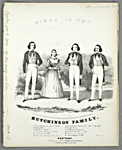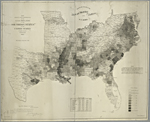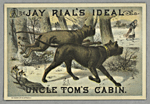Slavery and Abolitionists
"All true friends of Emancipation/ Haste to Freedom's Railroad Station;
Quick into the Cars get seated,/ All is ready, and completed.
Put on the Steam! All are crying,/ And the Liberty Flags are flying." — from "Get Off the Track," lyrics by Jesse Hutchinson, 1844
The importation of slaves was prohibited by congressional statute
in 1807, and individual Northern states banned ownership of slaves
over the next twelve years. In the South, domestic use and sale of
slaves continued until passage of the Thirteenth Amendment (1865).
The years in between saw the rise of the Abolitionist Movement in
America. Although Abolitionist and Anti-Slavery societies,
periodicals, and fund-raising events focused principally on the
mid-Atlantic and New England states, the issue was carried West
with settlers and performers.
Following the Missouri Compromise (1820-21) and the Compromise of 1850, the
issue of slavery was debated each time a territory voted on
statehood, and touring singers, most notably the Hutchinson
Family, spread the Abolitionist message to territory voters. Their
songs, and Abolitionist poetry set to hymns, were published in
songsters and anthologies that were used as fund-raisers for
individual Anti-Slavery societies and for legal battles against
the Fugitive Slave Laws in the 1840s and 1850s. Individual popular
and parlour songs were also published and sold to benefit the
cause. Many of these martial songs and hymns, such as George F.
Root's "The Battle Cry of Freedom," are still popular
today.
Of all the performance texts of the anti-slavery cause, the best
remembered are dramatizations of Harriet Beecher Stowe's 1852
novel Uncle Tom's Cabin. Stowe herself denounced these
adaptations as simplistic, and performances were seldom used as
Abolitionist fund-raisers, so they should not be considered
documents of the movement. But they were the century's
most-performed melodramas and remained a staple of traveling
theater families throughout the century.
Refer to Map of the United
States and Mexico (1859), which
details explorers' trails, transportation routes,
settlement patterns, and locations of mineral wealth.
These factors greatly affected tours undertaken by
performing artists in America during the first half of
the 19th century.


